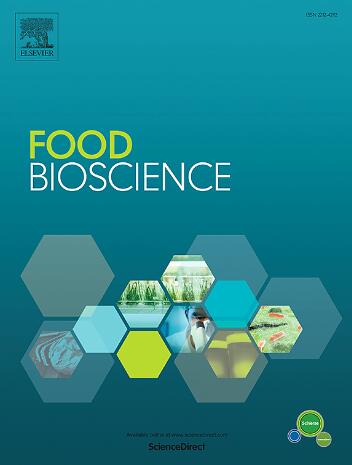Spray drying and characterisation of anthocyanin rich microcapsules from jaboticaba juice with maltodextrin
IF 4.8
1区 农林科学
Q1 FOOD SCIENCE & TECHNOLOGY
引用次数: 0
Abstract
Natural plant pigments, especially anthocyanins have gained significant attention in recent years, primarily due to their pharmacological significance. However, they are unstable and prone to degradation due to processing factors such as temperature, light exposure, oxidation and/or pH change. Encapsulation is one of the widely accepted techniques to protect the natural colorants from degradation. Maltodextrin was a commonly used carrier due to its high solubility in juice, neutral taste and low viscosity properties. The study aimed to evaluate the effects of maltodextrin (10–25 %) on the physicochemical properties of spray dried microcapsules of anthocyanin rich jaboticaba juice. Jaboticaba berries were blended and subjected to ultrasonication to enhance anthocyanin extraction in the juice. Particle shrinkage was observed for microcapsules containing 25 % maltodextrin, despite the microcapsules achieved the highest encapsulation efficiency, 97.1 % and total anthocyanin content. Although maltodextrin content more than 15 % resulted in the highest lightness of jaboticaba microcapsules, their colour intensity expressed in chroma was reduced. In contrast, 15 % maltodextrin produced spherical microcapsules with a narrow range of particle size (6.42–8.65 μm) and exhibited intermediate flowability and compressibility. Microcapsules with 15 % maltodextrin retained the highest content of cyanidin 3-glucoside (51 mg/L), though their encapsulation efficiency was only 65 %. Based on the physicochemical examination, 15 % maltodextrin was the most suitable composition for encapsulating jaboticaba juice. More importantly, it retained the highest cyanidin 3-glucoside content and produced monodisperse and micron-scale size capsules.

麦芽糖糊精喷雾干燥法制备富花青素微胶囊
天然植物色素,特别是花青素近年来受到了广泛的关注,主要是由于它们的药理意义。然而,由于温度、光照、氧化和/或pH值变化等加工因素,它们是不稳定的,容易降解。包封是一种被广泛接受的保护天然色素不被降解的技术。麦芽糊精因其在果汁中的溶解度高、口感中性、粘度低等特点而成为常用的载体。研究了麦芽糊精(10 - 25%)对喷雾干燥的花青素花青素汁微胶囊理化性质的影响。用超声波法对牙买加蓝莓进行混合,以提高其汁液中花青素的提取率。当麦芽糖糊精含量为25%时,微胶囊的包封率最高,达到97.1%,总花青素含量最高。当麦芽糖糊精含量超过15%时,微胶囊的亮度最高,但其色度表达强度降低。15%麦芽糖糊精制备的球形微胶囊粒径范围较窄(6.42 ~ 8.65 μm),具有中等的流动性和压缩性。当麦芽糊精含量为15%时,微胶囊中花青素3-葡萄糖苷含量最高(51 mg/L),但包封率仅为65%。经理化检验,15%的麦芽糖糊精是夹心草汁包封的最佳配方。更重要的是,它保留了最高的花青素3-葡萄糖苷含量,并生产了单分散和微米级尺寸的胶囊。
本文章由计算机程序翻译,如有差异,请以英文原文为准。
求助全文
约1分钟内获得全文
求助全文
来源期刊

Food Bioscience
Biochemistry, Genetics and Molecular Biology-Biochemistry
CiteScore
6.40
自引率
5.80%
发文量
671
审稿时长
27 days
期刊介绍:
Food Bioscience is a peer-reviewed journal that aims to provide a forum for recent developments in the field of bio-related food research. The journal focuses on both fundamental and applied research worldwide, with special attention to ethnic and cultural aspects of food bioresearch.
 求助内容:
求助内容: 应助结果提醒方式:
应助结果提醒方式:


